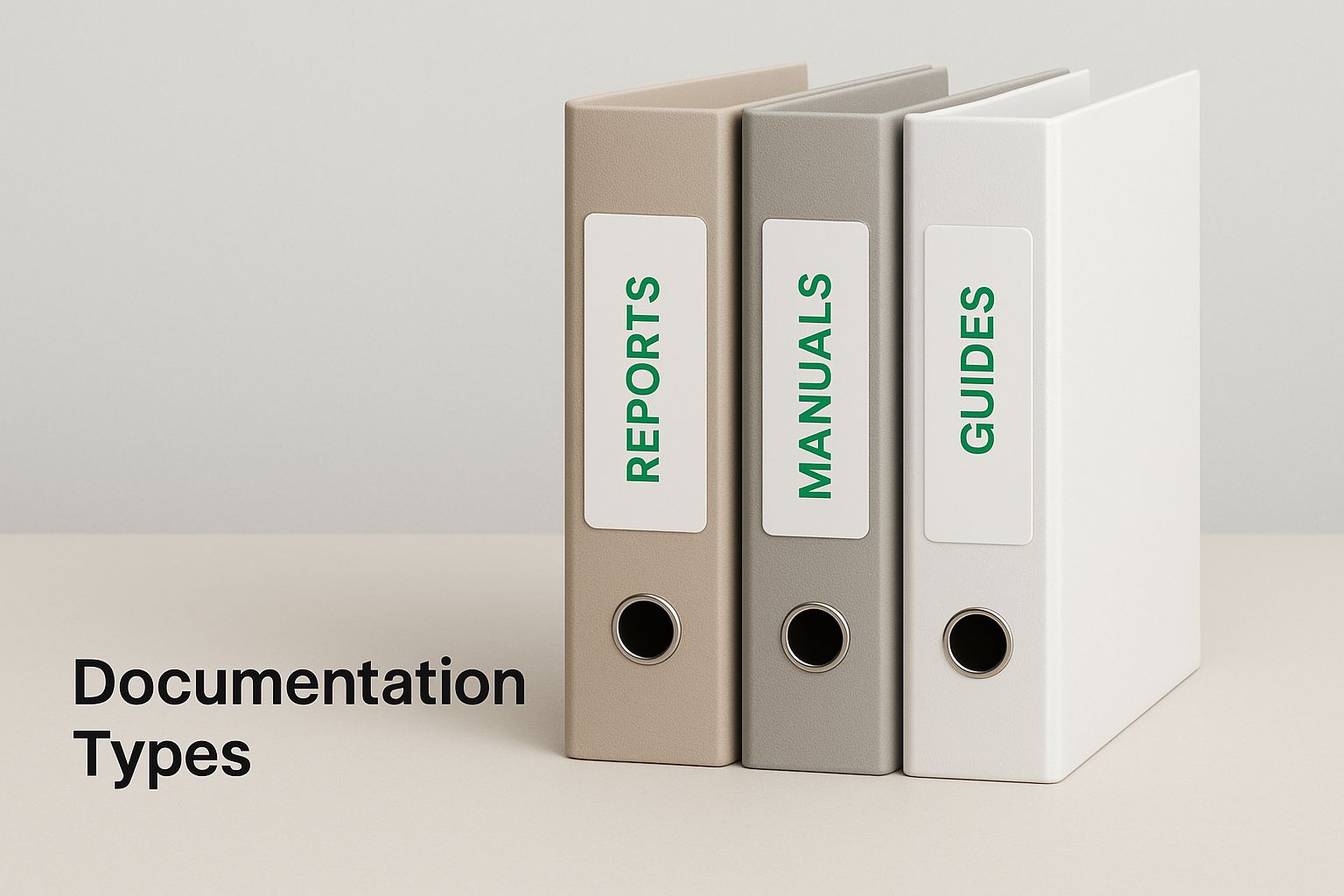Learn what does documentation mean and how it can benefit your business. Discover strategies and tips to create effective documentation today.
To grasp what documentation means today, let’s discard the old picture of dusty manuals and tedious paperwork. In the modern workplace, documentation is the living, breathing memory of a company. Think of it as the central nervous system that connects teams, preserves vital knowledge, and drives consistent action. It’s the collection of all essential information that would otherwise get lost, trapped in a key employee’s head or scattered across messy chat threads.
This move from simple record-keeping to strategic knowledge management is a core business need. The global market for document processing and editing services, which covers everything from creation to support, is growing rapidly. This expansion signals a clear demand for organized, easy-to-access information in every industry. You can dive deeper into this trend and its effects in this 2025 global market report. This demand shows that forward-thinking companies see documentation not as a chore, but as a real advantage.
Good documentation answers important questions before they can disrupt a project: How does this feature work? What was the logic behind this decision? What’s our standard process for this customer issue? Without clear answers, teams waste time, make expensive errors, and find it hard to grow.
Here is a great example of how documentation is built to answer these kinds of questions, showing its different parts and how they relate.

This image illustrates that documentation isn’t one single item but a system of connected pieces, from broad management plans to specific technical details.
Ultimately, documentation is about building systems that help people work smarter. It converts tribal knowledge—information known only to a few—into a shared resource, making sure your organization’s operational intelligence builds over time. It’s the groundwork that enables smooth onboarding, quick problem-solving, and lasting growth. For a more detailed look, our other article offers an in-depth definition of documentation and its key principles.
By creating and maintaining this shared understanding, you break down knowledge silos and build a more adaptable and productive team. This isn’t about making more work; it’s about making all future work much easier.
Just as a mechanic needs more than a single wrench, an effective organization needs more than one type of documentation. Knowing which kind to create for a specific situation is the difference between building a useful resource and a digital paperweight. It’s about picking the right format for the right audience to achieve a specific goal. Let’s break down the essential categories that produce real business results.
Imagine your most skilled team member suddenly wins the lottery. How much operational knowledge walks out the door with them? Process documentation is your defense against this very scenario. It captures the step-by-step instructions for recurring tasks, ensuring consistency and quality no matter who performs the job. This could be anything from a customer support workflow to a software deployment checklist.
Running alongside this is project documentation. This type acts as the single source of truth for a specific initiative. It’s the official record of the project’s life, containing:
Without it, projects suffer from scope creep, miscommunication, and repeated mistakes. Tools like Confluence are often used to create a central hub for this kind of information, keeping everyone aligned.
This next category focuses on the product itself. Technical documentation is written for an internal audience, primarily developers and engineers. It includes API references, architecture diagrams, and coding standards. Its purpose is to ensure the development team builds and maintains the product coherently.
On the other hand, user-facing documentation is for your customers. This includes user guides, tutorials, and FAQs designed to help them succeed with your product. A great user manual can reduce support tickets by over 50%, turning frustrated users into happy advocates.
To clarify how these different types serve your business, here’s a practical breakdown of their purpose, audience, and impact.
Each documentation type plays a distinct and important role. Process and project docs keep your internal engine running smoothly, while technical and user-facing docs ensure your product is both well-built and well-received.
The infographic below shows how these categories are organized to serve unique needs. By understanding this structure, you can focus your efforts where they will have the most significant impact on both internal efficiency and customer satisfaction. Each type is a tool in your kit, ready to be deployed for a specific strategic need.

Many people think of documentation as just a chore—another box to check off a list for compliance. But the reality is that great documentation is like the central nervous system of a growing business. When it’s healthy and well-maintained, every part of the company operates smoothly. When it’s ignored, the whole organization gets bogged down by confusion and mistakes. It’s the unseen structure that separates businesses that stagnate from those that scale effectively.

So, what does documentation mean for the bottom line? It’s about turning scattered knowledge into a real, concrete asset. This asset directly cuts down on friction in critical business areas. For example, companies with solid documentation can slash onboarding time for new team members from weeks down to a matter of days. This means new hires start adding value much faster, giving overall productivity a significant boost.
Good documentation also acts as a safety net against expensive errors. A clear, easy-to-find guide on a key customer service process can be the difference between keeping a happy client and losing their business forever. It also protects your most valuable asset: institutional knowledge. When a seasoned employee leaves, their expertise doesn’t just vanish. It remains documented, shielding the business from knowledge gaps and preventing the team from making the same mistakes over and over.
These benefits aren’t just abstract ideas; they show up in real-world performance. Organizations that take a mature approach to documentation consistently stay ahead of their rivals because they are more nimble, consistent, and resilient. In fields that depend heavily on knowledge, this creates a strong competitive advantage.
This value is clear in the fast adoption of new documentation tools. For instance, Intelligent Document Processing (IDP) is experiencing massive growth. The market is projected to skyrocket from ****17.8 billion by 2032. This growth is led by large companies, particularly in finance, where 71% have already adopted IDP to improve efficiency and accuracy. This trend highlights a widespread understanding that managing knowledge is no longer optional. For a deeper dive, you can explore the full report on the Intelligent Document Processing market.
Ultimately, putting resources into documentation isn’t just an expense—it’s an investment in your company’s future. It lays a solid groundwork for growth, lowers operational risk, and gives your team the tools they need to do their best work. For any business that wants to achieve lasting success, it’s a strategic necessity.
Theory is helpful, but seeing documentation deliver real-world results is what truly demonstrates its impact. These aren’t just abstract ideas; they are genuine stories of progress where clear, organized documentation drove measurable business improvements. Each story proves that great documentation is about making tangible gains, not just ticking a box.
Imagine a tech startup exploding from 10 to 100 employees in just over a year. Their biggest hurdle was onboarding dozens of new engineers quickly without slowing down development. Their solution was to build a central, living wiki using a tool similar to the built-in wiki feature on GitHub.
This is what a simple project wiki can look like, acting as a single source of truth for the entire team.
This centralized hub allowed new hires to find information independently, covering everything from setting up their development environment to understanding key architectural choices. The result? The company successfully expanded its team while keeping development on track—a challenge where many startups falter. You can learn more about maintaining high standards as you grow by reading about code documentation best practices.
The benefits of solid documentation reach far beyond the tech industry. A large healthcare organization implemented standardized procedural documents for its clinical staff and managed to reduce patient safety incidents by 40%. By using clear, visual checklists and guides, they removed any guesswork during critical procedures.
Likewise, a manufacturing company struggled with high costs and long training periods for new machine operators. They replaced dense, text-heavy manuals with visual, step-by-step guides full of photos and diagrams. This simple change cut new-hire training time in half. It not only saved money but also boosted employee confidence and reduced errors on the production line. These examples show that effective documentation leads directly to safer, more efficient, and more profitable operations.
The biggest failure of documentation isn’t incorrect information; it’s being completely ignored. The hard truth is that most guides and manuals sit on a digital shelf, gathering dust and failing their one true purpose. To understand what good documentation means in a practical sense, think like a bridge builder. Your job is to connect complex knowledge with busy people who need fast, reliable answers. The goal isn’t just to write things down but to create a resource that becomes essential.
So, what separates documentation that empowers from documentation that frustrates? It all comes down to user-centric design. People don’t read documentation for fun; they use it to solve a specific problem. Every single element, from a heading to a screenshot, must serve that immediate need. This means structuring information for quick scanning, using clear language, and writing in a voice that speaks directly to the user, not at them.
The secret is to anticipate the user’s journey before they even begin. Instead of long, dense paragraphs that feel like a chore to read, you need to break information into digestible, easy-to-find chunks. Here’s how you can make your documentation much more user-friendly:
To make sure your documentation is a go-to resource, it’s vital to follow established best practices. This helps you avoid common traps like using internal jargon, burying important warnings in fine print, or creating an illogical flow. For example, putting setup instructions after the advanced troubleshooting section is a classic mistake that instantly confuses and alienates new users.
To illustrate the difference between helpful and frustrating documentation, here’s a breakdown of excellent practices versus common pitfalls.
A practical comparison revealing what separates documentation that gets used from documentation that gets ignored
Focusing on these excellent practices transforms your documentation from a passive file into an active tool that builds user trust and competence.
The demand for clear, secure, and verifiable information is growing rapidly. The document verification market, which centers on security and compliance, is a great indicator of this trend. It’s projected to expand from ****5.07 billion by 2025, driven by the need for trustworthy information. You can explore more about this market in a detailed document verification market report. This growth highlights that creating reliable, user-friendly documentation is no longer just a nice-to-have—it’s a core business requirement. By focusing on the user’s needs, you can transform your documentation from a neglected file into a powerful tool for success.
The old ways of creating and managing documentation are fading fast, replaced by smart technology built to automate tedious work and elevate quality. Artificial intelligence now plays a central part in handling this critical task. Think of these new tools as expert assistants that manage the repetitive parts of documentation, freeing up your team to focus on high-level strategy and making sure the content is truly helpful. This isn’t about replacing human experts; it’s about giving them superpowers.
For developers and engineers, this means less time spent on manual writing and more time spent on building. Tools like DocuWriter.ai are designed to tackle this exact problem. They plug directly into the development workflow to automate the creation of technical and API documentation. This saves a huge amount of time—some organizations report reducing creation time by up to 75%—and ensures the final output is consistent, accurate, and always in sync with the latest code changes.
So, what does this look like in practice? These tools analyze your source code, understand its structure and functions, and then generate clear, human-readable explanations. They can automatically create code comments, draft full API references, and even produce UML diagrams to help visualize the system’s architecture. This process removes the friction that so often leads to outdated or incomplete documentation.
Below is an example of how a tool like DocuWriter.ai presents its features, focusing on automating code documentation right from the source.
The screenshot shows a clean interface where developers can instantly generate documentation for their code, turning what was once a complex manual task into a simple, automated step.
This intelligent automation goes beyond just the first draft. Here’s how these modern tools support the entire documentation lifecycle:
Ultimately, what does documentation mean in an age of AI? It means shifting from a static, labor-intensive process to a dynamic, intelligent system. It’s about creating resources that are not only better written and more helpful but also dramatically more efficient to produce and maintain. This technology is quickly becoming a standard part of the modern software development toolkit, helping teams build better products, faster.
Now that you understand what documentation means and its business impact, it’s time to create an action plan. Effective documentation doesn’t just happen; it requires a deliberate roadmap. This guide breaks down the implementation into clear phases, turning theory into practical steps you can take right now.
Before you can build, you need to survey the land. Start with an honest audit of your current documentation—or the lack of it. Pinpoint the biggest pain points where missing or unclear information is causing friction for your team.
The answers to these questions will highlight the most critical areas to document first. By focusing your initial efforts on solving these immediate problems, you’ll score quick wins and build momentum for your documentation goals.
With your priorities set, it’s time to start creating content. The secret to long-term success is consistency. By establishing simple standards from the beginning, you ensure all documentation has a uniform look and feel, making it easier for everyone to find and use information.
Documentation is a living asset, not a one-and-done project. To keep it useful, you need to establish routines to keep it current. A monthly review of key documents can prevent them from becoming stale and misleading.
To prove its value and ensure continued support, track metrics like a reduction in onboarding time or fewer support tickets related to a documented process. These numbers provide concrete evidence of your efforts and secure ongoing buy-in from your team and leadership.
Ready to make documentation a core strength instead of a chore? Discover how DocuWriter.ai can automate your documentation process, helping you build and maintain high-quality resources with a fraction of the effort.